Emmy-Nominated “House of the Dragon” Cinematographer Catherine Goldschmidt on Lensing a Bloody Family Affair
House of the Dragon cinematographer Catherine Goldschmidt stepped back into Westerosi history in the Game of Thrones prequel and into Emmys history when she was nominated for an Emmy for her work in the 8th episode of season one, “The Lord of the Tides.” In that episode, Goldschmidt was tasked with subtly taking viewers six years into the future as two bloody succession battles are taking place. The immediate quarrel is over who will succeed Lord Corlys Velaryon (Steve Toussaint) on the Driftwood Throne, with a fight brewing over the chosen heir, Corlys’ grandson Lucerys (Elliot Grihault) and his brother, Ser Vaemond Velaryon (Wil Johnson). Meanwhile, an ailing King Viserys (Paddy Considine), wants to bring his entire family together one last time and make clear his own chosen successor, his daughter Princess Rhaenyra (Emma D’Arcy), will rule. Yet her former best friend (and father’s current wife), Queen Alicent Hightower (Olivia Cooke), has other ideas, and the two are moving closer to open war with one another.
“The Lord of the Tides” was one of the most thrilling episodes of the season, a family saga for the ages, a cauldron of resentment and familial rage finally boiling over. Goldschmidt brought it off beautifully and, in the process, is now the only woman nominated in the Outstanding Cinematography For A Series (One Hour) category this year and only the fourth woman ever nominated in the 67 years this award has been given. If she wins, she’ll be the first woman ever to do so.
We spoke to Goldschmidt about the differences between the shooting styles of Game of Thrones and House of the Dragon, capturing a family at war with itself, and the subtle changes to iconic locations that turned this prequel series into a historical epic.
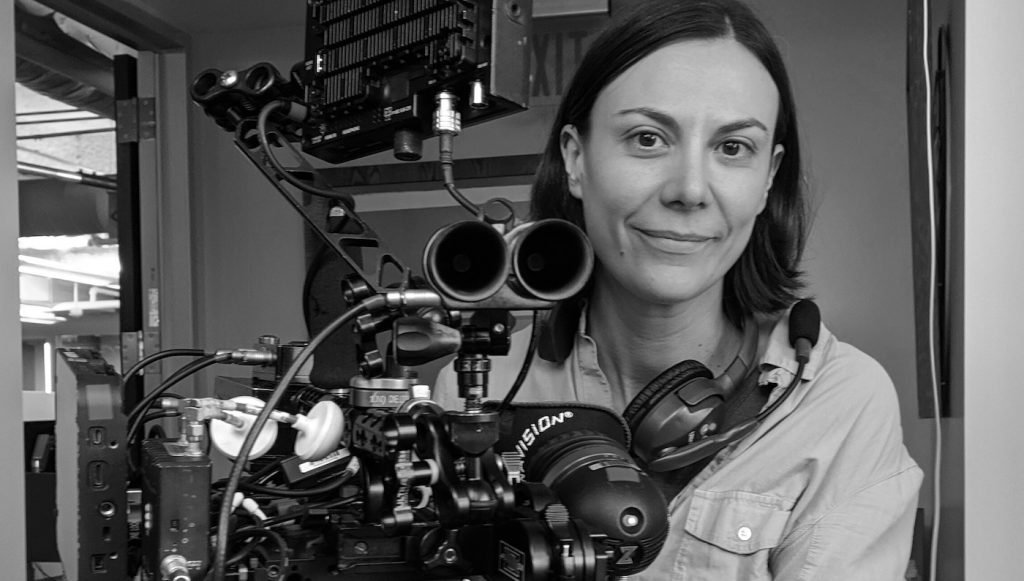
Can you describe how you modified your approach to shooting this series compared to how Game of Thrones was filmed?
Although House of the Dragon is a prequel to Game of Thrones, it is a brand-new show with a brand-new look. We shot on Alexa 65 and Alexa LF cameras with Arri DNA lensing, which was a completely different choice from the original show. The color palette of GoT was constantly shifting to define the different worlds, but House of the Dragon Season One is about one family in one place, so the palette could be more connected to character and story than to location. I think the biggest way we were consistent with GoT was in how we moved the camera – classic dolly and crane moves and very little handheld. We did use Steadicam more than the original series, however.
How did you capture the world of Westeros in episode 8, “The Lord of the Tides”? There are so many beautiful little details that let a viewer fall into this fantasy realm while keeping the characters and their motivations front and central?
It’s definitely a team effort as far as the overall tone goes, and also the attention to detail in terms of the world-building. I’ll give you a specific example from “The Lord of the Tides” that will give you a taste of how the collaboration works. Towards the beginning of the episode, we have a small, dialogue-free scene in which we see Daemon collecting some dragon eggs. So, we all know what dragon eggs look like from Game of Thrones, but as far as where he would find them, how he would find them, what tools he would use to find them…this was all new, and we had to work together with the props team, with production design, with VFX and SFX, under the direction of our showrunners Ryan [Condal] and Miguel [Sapochnik], as well as my director Geeta Patel, to figure out exactly what this scene would look like, and what it would entail.
What were you hoping to get across in this scene?
We wanted to create a sense of mystery with the sequence, and for me, that meant using shadow and silhouette as well as camera movement to reveal Daemon in this strange environment eventually. The scene takes place down a crevice of Dragonmount, and we discussed everything from how deep this crevice is to how Daemon gets down it to how the dragons get down it…everything had to make logical sense, even though we’re dealing with fantasy creatures. And that kind of reality-based logic also informed my lighting choices- where would the light come from if you’re down such a crevice? I had the art department make cracks in the rock ceiling of the set so that daylight could stream down in certain key places.
How would you describe the main emotional beats of “The Lord of the Tides” that you wanted to capture?
There’s a lot going on in this episode. All the characters are coming back together one last time before they break apart for the rest of the season. They all want something, and they’re all having a hard time getting it. Viserys wants to see his family reunited before he goes, and he wants to have everyone recognize Rhaenyra as his true heir. Rhaenyra wants to be the heir, and her succession is being challenged. Alicent is one of the key people challenging Rhaenyra’s succession because she wants her son Aegon [Tom Glynn-Carney] to rule instead. Alicent and Rhaenyra, once the closest of friends, are now enemies, and Viserys wants them to reconcile. The emotional spectrum of the episode ranges from love on the one hand to betrayal on the other.
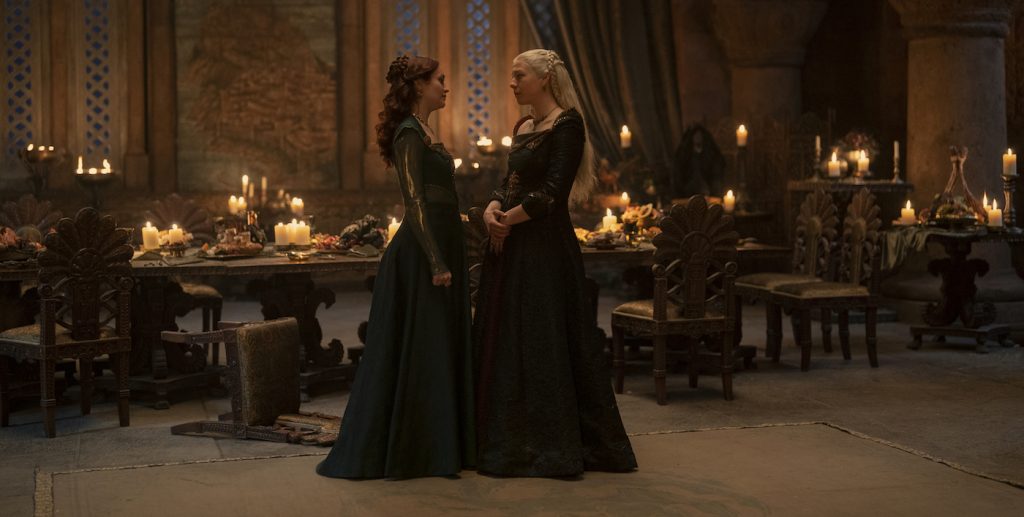
What was your collaboration like with director Geeta Patel and the great ensemble cast?
Collaborating with Geeta was and is (we’re doing Season Two together as we speak!) one of the greatest creative collaborations of my career so far. Geeta is incredibly generous as far as always wanting to hear my thoughts, always considering my perspective, and always being open to new ideas. She is like this with everyone on the crew and in the cast. She knows exactly what she wants and has a strong vision for the show, but at the same time, she really absorbs and synthesizes what everyone is bringing to the table. I love working with Geeta, and so does the entire cast and crew. My collaboration with the cast is definitely via Geeta. Geeta and I will discuss how we think a scene should be blocked, but then in rehearsal- she’ll always pose this as a suggestion rather than a mandate to the cast. They’re happy to oblige, but sometimes they’ll have new thoughts and ideas, which we always accommodate.
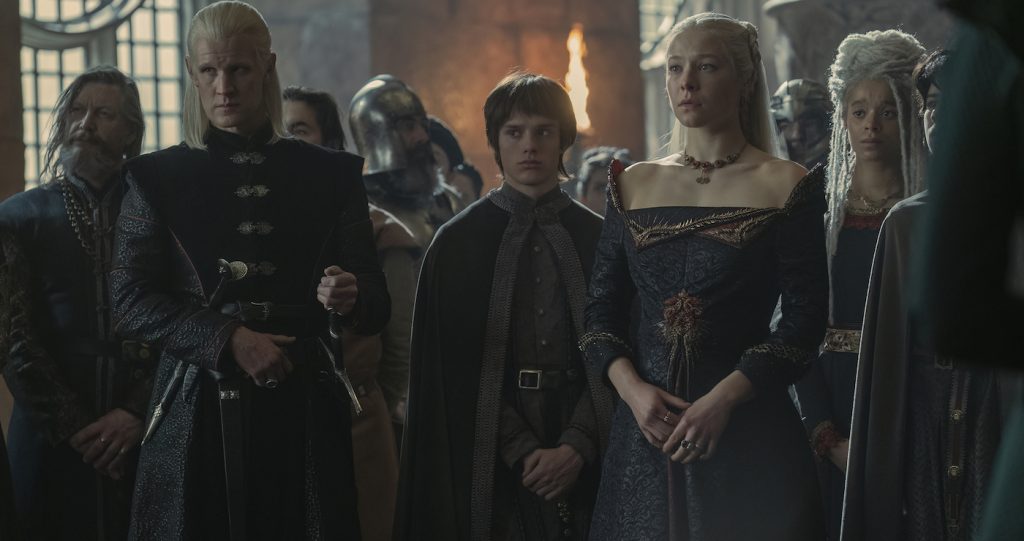
Can you describe the conversations you had with showrunners Ryan Condal and Miguel Sapochnik before you filmed a single frame on what the most important aspects of The House of the Dragon were to reveal to audiences?
We discussed the overall tone and that House of the Dragon is more of a historical epic than a fantasy show. We also discussed in great detail how “The Lord of the Tides” happens six years after the previous episode, and now that Alicent is in charge of the Red Keep, it is a colder, more austere place than it was under Viserys. We spoke a lot about Viserys’ look and how his illness would present in its most advanced state in our episode. Defining how this would work practically across all departments, including VFX, SFX, prosthetics, hair and makeup, costume, and cinematography, was very important to Ryan, Miguel, and Geeta.
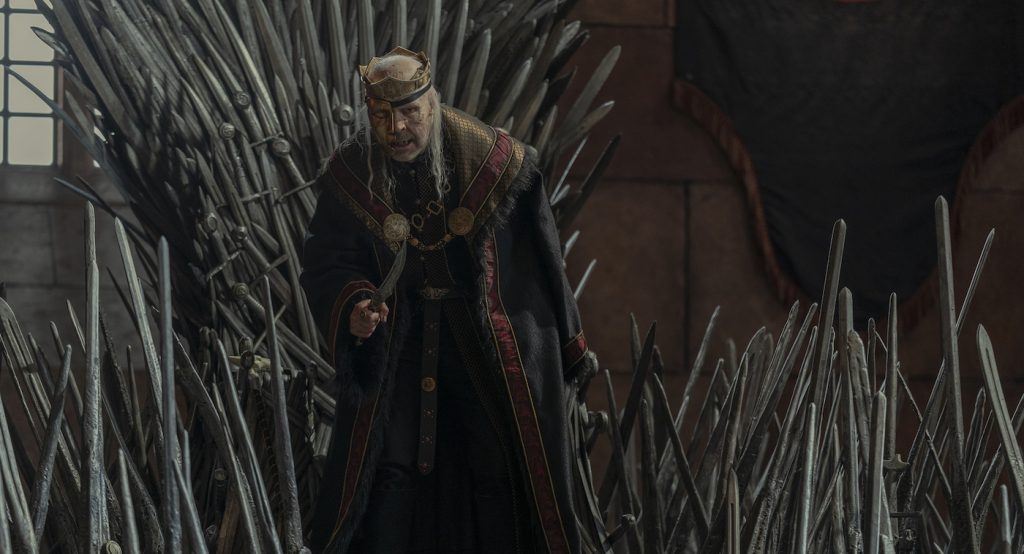
What was the approach to the scenes between Emma D’Arcy’s Princess Rhaenyra and Eve Best’s Princess Rhaenys, considering the latter believed the former murdered her son?
We have a key scene between Rhaenyra and Rhaenys in the Godswood where Rhaenyra essentially begs Rhaenys to take her side and back her succession claim. This is complicated for Rhaenys not only because of her son but also because, as a woman, she herself was passed over for succession, and the kingdom voted for a man to lead instead. The dynamics are fascinatingly complex between these two women, and Geeta and I both drew lots of parallels to our own experiences of being women in leadership roles traditionally held by men. Because of where the scene falls in the episode – in the very next scene, Rhaenyra comes to her father’s bedside at night to beg for his help also – we saw it tonally as “ a storm is coming.” Although we shot on a very sunny day, we wanted the scene to feel like the end of the day and with a storm coming also, so we added lots of wind from SFX, and I blocked out the sun as much as humanly possible.
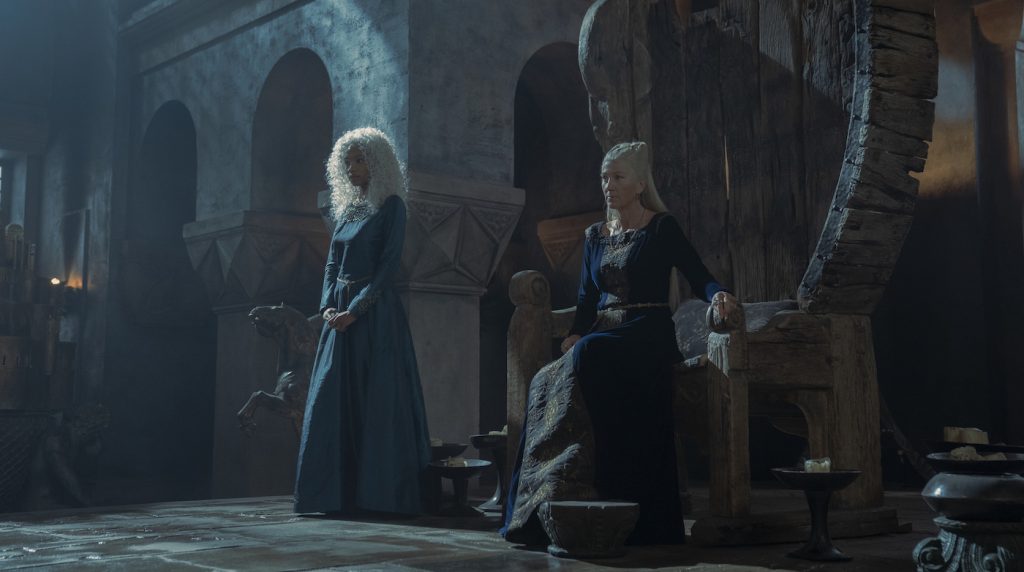
Do any particular moments or sequences from this episode stand out to you as singularly special for you?
I love the moment when Viserys enters the throne room. It’s such a major event in our big Throne room scene and in the episode in general, and we spent a lot of time planning all the angles we wanted to shoot it from. Chiefly, we wanted to be in Viserys’ POV- leading him, following him, and showing what he sees. It’s an incredibly emotional moment for him as well as everyone else in that room, and Paddy performed the walk so well. The moment when Viserys’ crown falls off wasn’t scripted, but as soon as it happened once, everyone felt that it was exactly right for the scene, and we kept shooting it this way – pure kismet!
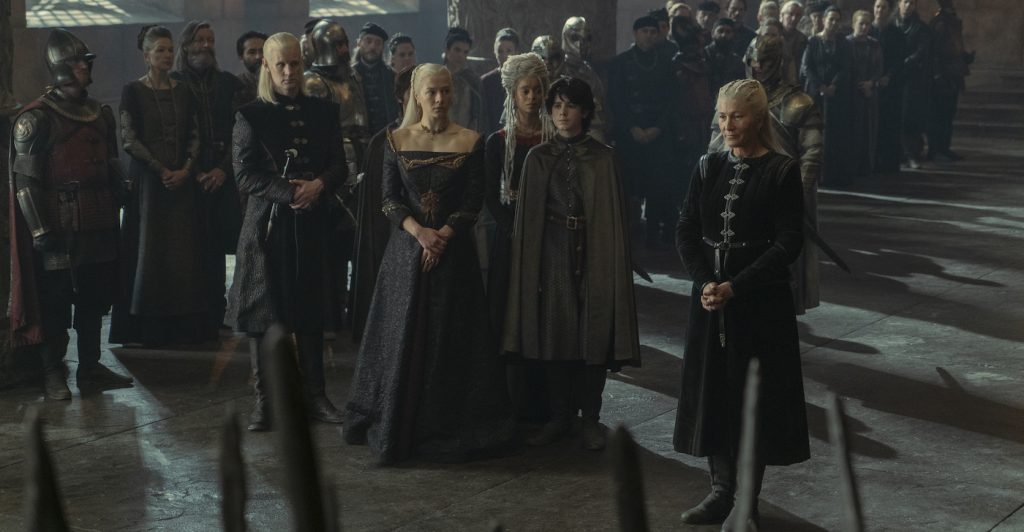
The Red Keep looks a bit different, a bit more forbidding, in House of the Dragon. Can you describe how you capture the Gothic appeal of it?
Ryan and Miguel both impressed upon Geeta and me how different the Red Keep should feel to Rhaenyra, who is coming back for the first time in six years to find she doesn’t recognize it. We worked with Production Designer Jim Clay and Set Decorator Claire Richards to strip the Red Keep back in terms of furniture, decoration, and lighting. I went for colder, harsher, more wintery light with more contrast. Jim designed this very imposing Star of the Seven for the Great Hall, and we shot Rhaenyra dwarfed below it to show Alicent’s power over her at the start of the episode.
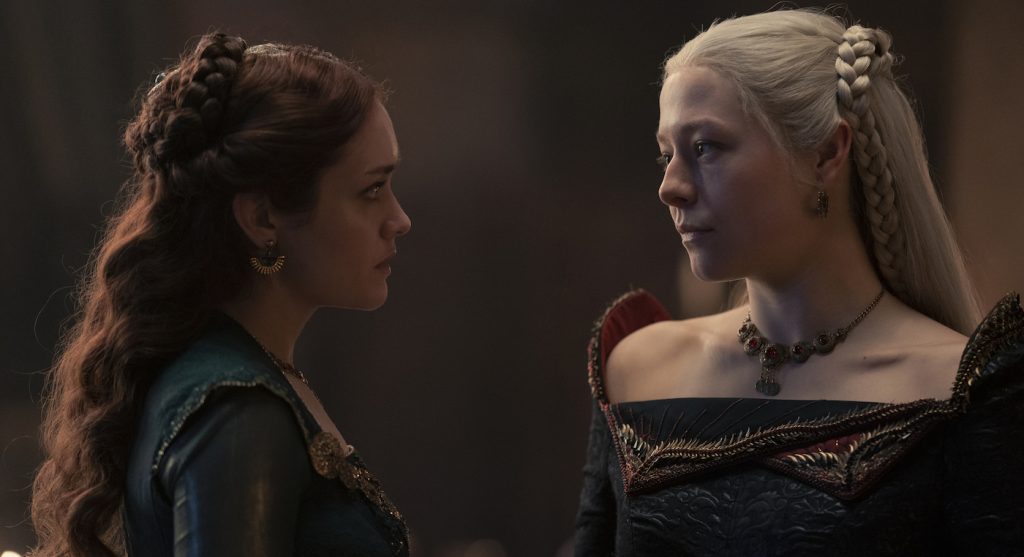
Can you tell me about the “Hero Triangle” and how that idea was conceived and executed?
The “hero triangle” is how we referred to the relationship dynamics between Viserys at the apex, Rhaenyra on one side, and Alicent on the other. This triangle informed all of our blocking, lighting, and lensing decisions. For example, in the dinner scene, we placed Viserys right in the middle of the table, putting Alicent and her family on one side of him and Rhaenyra and her family on the other. In this way, we visualized the drama: even though Viserys is desperately trying to bring both sides together, he is also the reason why they are apart.
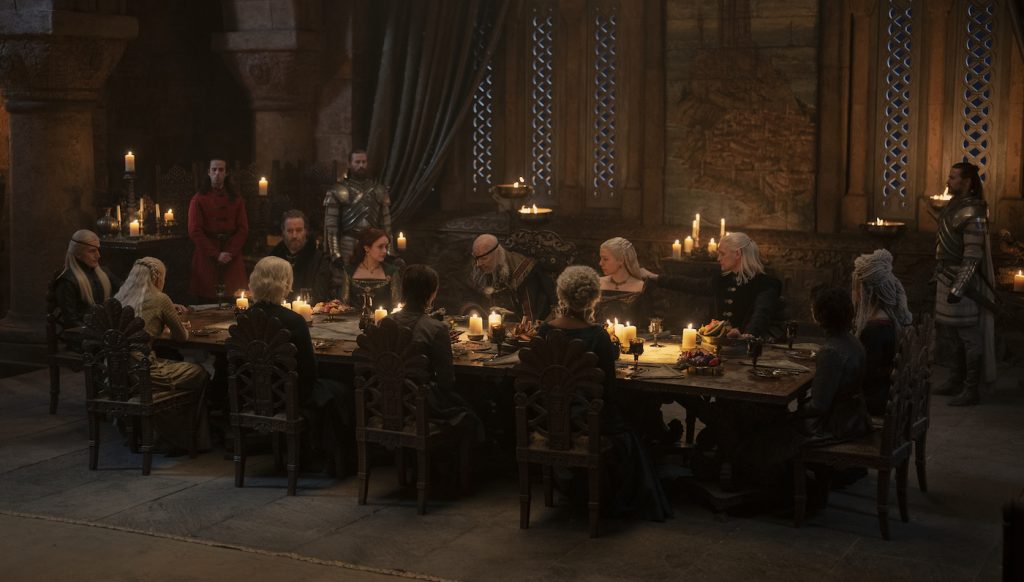
Congratulations, by the way, on your nomination. It’s a historic one — you’re the only the fourth woman nominated in the Outstanding Cinematography for a Series in the one-hour category in the show’s 67 years — how does that feel?
Thank you! I’m very honored to be nominated alongside so many great cinematographers who have all done incredible work. It’s true I am the only woman to be nominated this year; however, I do want to acknowledge the women who have been nominated in this category before me: Autumn Durald, Zoe White, and Anette Haellmigk, who was nominated twice for her fantastic work on Game of Thrones! It’s sadly true that no woman has ever won the Emmy award in this category, but who knows- maybe this is the year!
For more on House of the Dragon, check out these stories:
“House of the Dragon” Showrunner Teases Five New Dragons For Season 2
House of the Dragon” Season 2 Coming to HBO in 2024
“House of the Dragon” Costume Designer Jany Temime’s Deadly Elegance
Featured image: Ewan Mitchell, Rhys, Ifans, Olivia Cooke, Paddy Consdine, Emma D’Arcy. Photograph by Ollie Upton / HBO



